Paul Friedrich Posenenske | |
|---|---|
| Born | September 9, 1919 |
| Died | April 2004 |
| Occupation | Architect |
Paul Friedrich Posenenske (9 September 1919 in Wroclaw - April 2004) was a German architect of functionalism.
Paul Friedrich Posenenske | |
|---|---|
| Born | September 9, 1919 |
| Died | April 2004 |
| Occupation | Architect |
Paul Friedrich Posenenske (9 September 1919 in Wroclaw - April 2004) was a German architect of functionalism.
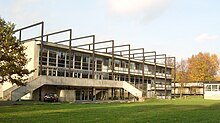

Posenenske studied from 1936 to 1941 at the Technische Hochschulen in Breslau (now Wrocław University of Science and Technology) and in Charlottenburg (now Technische Universität Berlin) and has worked since 1945 in various state building departments of Hesse. There, he designed especially public building, which are characterized by a very complex modernity. In many buildings, artists were involved, for art and for the color scheme. The dormitories in Frankfurt, however, were very purist and followed the forms which were introduced by Ferdinand Kramer at the Frankfurt University.
From 1958 he was a professor at the State Academy of Fine Arts in Kassel (today part of University of Kassel). In the same year he set up his own architectural offices in Offenbach am Main and Kassel. The transformation of the 18th-century architecture Schloss Wilhelmshöhe with a deliberately avant-garde interior design into a modern museum was heavily criticized by traditionalists.
Paul Friedrich Posenenske was married to the painter and sculptor Charlotte Posenenske. In 1987 he moved with his wife to Pottum Westerwald, where he worked and lived until his death.

Kassel is a city on the Fulda River in northern Hesse, in central Germany. It is the administrative seat of the Regierungsbezirk Kassel and the district of the same name, and had 201,048 inhabitants in December 2020. The former capital of the state of Hesse-Kassel, it has many palaces and parks, including the Bergpark Wilhelmshöhe, which is a UNESCO World Heritage Site. Kassel is also known for the documenta exhibitions of contemporary art. Kassel has a public university with 25,000 students (2018) and a multicultural population.
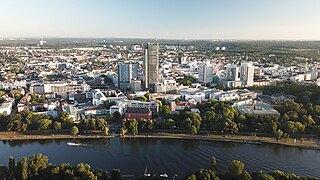
Offenbach am Main is a city in Hesse, Germany, on the left bank of the river Main. It borders Frankfurt and is part of the Frankfurt urban area and the larger Frankfurt Rhein-Main urban area. It has a population of 138,335.
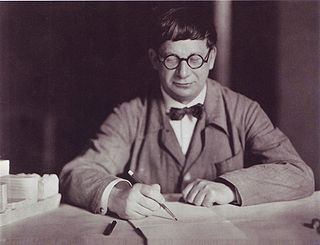
Hans Poelzig was a German architect, painter and set designer.
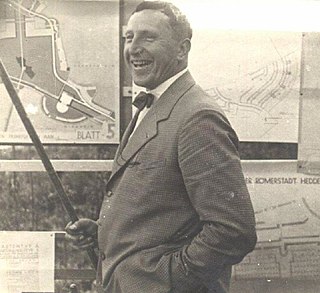
Ernst Georg May was a German architect and city planner.

German Bestelmeyer was a German architect, university lecturer, and proponent of Nazi architecture. Most of his work was in South Germany.
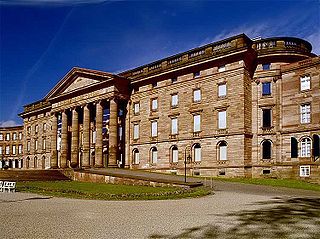
The Wilhelmshöhe Palace is a Neoclassical palace located in Bad Wilhelmshöhe, a part of Kassel, Germany. It was built for Landgrave Wilhelm (William) IX of Hesse in the late 18th century. Emperor Wilhelm II made extensive use of it as a summer residence and personal retreat.

Leo von Klenze was a German architect and painter. He was the court architect of Ludwig I of Bavaria.

Bernhard Hans Henry Scharoun was a German architect best known for designing the Berliner Philharmonie and the Schminke House in Löbau, Saxony. He was an important exponent of organic and expressionist architecture.

Kassel-Wilhelmshöhe is a railway station in the city of Kassel, in the German state of Hesse. It is the city's most important railway station, as it is connected to the Hanover-Würzburg high-speed rail line, with InterCityExpress services calling at the station.

Ferdinand Kramer was a German architect and functionalist designer.
Stephan Braunfels is a German architect.

Bergpark Wilhelmshöhe is a landscape park in Kassel, Germany. The area of the park is 2.4 square kilometres, making it the largest European hillside park, and second largest park on a hill slope in the world. Construction of the Bergpark, or "mountain park", began in 1689 at the behest of the Landgraves of Hesse-Kassel and took about 150 years. The park is open to the public today. Since 2013, it has been a UNESCO World Heritage Site because of its monumental Baroque architecture and its unique fountains and water features.

Kassel Hauptbahnhof is a Deutsche Bahn railway station in the city of Kassel, in the German state of Hesse. Situated in the central borough of Mitte, it is the city's second important railway station after the opening of Kassel-Wilhelmshöhe in 1991; and so it is the only Hauptbahnhof that is not the main station of its city.

Kunsthochschule Kassel is a college of fine arts in Kassel, Germany. Founded in 1777, it is a semi-autonomous department of the University of Kassel.

Johannes Krahn was a German architect and an academic teacher.
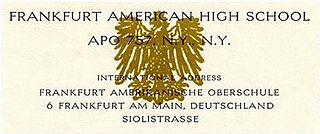
Frankfurt American High School (FAHS) was a Department of Defense Dependents Schools (DoDDS) system school located on what was once known as the Abrams Complex in Frankfurt, Germany. One of DoDDS original six high schools in Germany, the school served the children of American military, government and civilian personnel from 1946 until its closing in 1995. Originally known as the "Maroon Raiders", the "Eagle" was adopted as the school's mascot during the 1948–49 school year. The school's colors are black and gold. The motto is "Eagles Über Alles."

Richard Lucae was a German architect and from 1873 director of the Berliner Bauakademie.

Hans Grisebach was a German architect whose buildings provided a backdrop for many celebrities from the arts world.

Helmut Hentrich was a German architect who became particularly known for his striking high-rise buildings in the 1960s and 1970s. The architectural firm he founded, Hentrich, Petschnigg und Partner (HPP), still exists under the name HPP Architekten.

Volker Staab is a German architect.